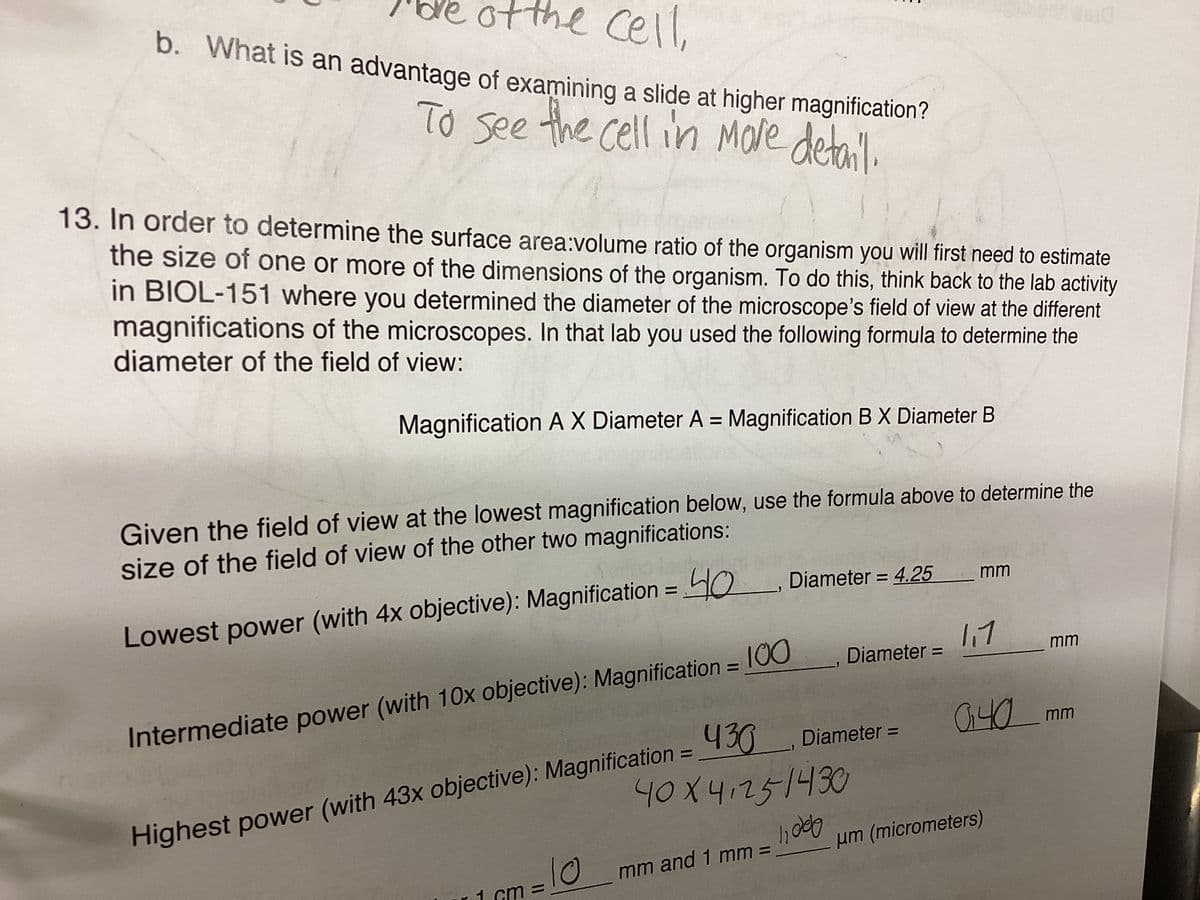of the cell, of examining a slide at higher magnification? To see the cell in More detail. b. What is an advantage 13. In order to determine the surface area:volume ratio of the organism you will first need to estimate the size of one or more of the dimensions of the organism. To do this, think back to the lab activity in BIOL-151 where you determined the diameter of the microscope's field of view at the different magnifications of the microscopes. In that lab you used the following formula to determine the diameter of the field of view: Magnification A X Diameter A = Magnification B X Diameter B
of the cell, of examining a slide at higher magnification? To see the cell in More detail. b. What is an advantage 13. In order to determine the surface area:volume ratio of the organism you will first need to estimate the size of one or more of the dimensions of the organism. To do this, think back to the lab activity in BIOL-151 where you determined the diameter of the microscope's field of view at the different magnifications of the microscopes. In that lab you used the following formula to determine the diameter of the field of view: Magnification A X Diameter A = Magnification B X Diameter B
Anatomy & Physiology
1st Edition
ISBN:9781938168130
Author:Kelly A. Young, James A. Wise, Peter DeSaix, Dean H. Kruse, Brandon Poe, Eddie Johnson, Jody E. Johnson, Oksana Korol, J. Gordon Betts, Mark Womble
Publisher:Kelly A. Young, James A. Wise, Peter DeSaix, Dean H. Kruse, Brandon Poe, Eddie Johnson, Jody E. Johnson, Oksana Korol, J. Gordon Betts, Mark Womble
Chapter4: The Tissue Level Of Organization
Section: Chapter Questions
Problem 17RQ: Under the microscope, a tissue specimen shows cells located in spaces scattered in a transparent...
Related questions
Question
13
how did they get 4.25?

Transcribed Image Text:of the cell,
b. What is an advantage of examining a slide at higher magnification?
To see the cell in More detail.
13. In order to determine the surface area:volume ratio of the organism you will first need to estimate
the size of one or more of the dimensions of the organism. To do this, think back to the lab activity
in BIOL-151 where you determined the diameter of the microscope's field of view at the different
magnifications of the microscopes. In that lab you used the following formula to determine the
diameter of the field of view:
Magnification A X Diameter A = Magnification B X Diameter B
Given the field of view at the lowest magnification below, use the formula above to determine the
size of the field of view of the other two magnifications:
Lowest power (with 4x objective): Magnification=40, Diameter = 4.25
Intermediate power (with 10x objective): Magnification = 100
430
40X41251430
Highest power (with 43x objective): Magnification
1
m=
lo
mm and 1 mm =
Diameter =
Diameter =
lidelo
mm
1.1
mm
040 mm
μm (micrometers)
Expert Solution
This question has been solved!
Explore an expertly crafted, step-by-step solution for a thorough understanding of key concepts.
Step by step
Solved in 2 steps

Follow-up Questions
Read through expert solutions to related follow-up questions below.
Knowledge Booster
Learn more about
Need a deep-dive on the concept behind this application? Look no further. Learn more about this topic, biology and related others by exploring similar questions and additional content below.Recommended textbooks for you

Anatomy & Physiology
Biology
ISBN:
9781938168130
Author:
Kelly A. Young, James A. Wise, Peter DeSaix, Dean H. Kruse, Brandon Poe, Eddie Johnson, Jody E. Johnson, Oksana Korol, J. Gordon Betts, Mark Womble
Publisher:
OpenStax College

Anatomy & Physiology
Biology
ISBN:
9781938168130
Author:
Kelly A. Young, James A. Wise, Peter DeSaix, Dean H. Kruse, Brandon Poe, Eddie Johnson, Jody E. Johnson, Oksana Korol, J. Gordon Betts, Mark Womble
Publisher:
OpenStax College